Themed collection New Trends in Crystal Engineering

New trends in crystal engineering
The articles and highlights presented at the second CrystEngComm meeting, held in Nottingham in September 2004 are reviewed.
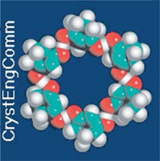
CrystEngComm, 2005,7, 1-19
https://doi.org/10.1039/B417413E
The innovative momentum of crystal engineering
Contributions of crystal engineering to the development of industrially relevant materials (e.g. pigments, dyes, agrochemicals and drugs) are described. Future needs and possible development trends in crystal engineering are discussed with a special emphasis on novel innovative materials.
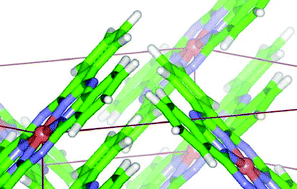
CrystEngComm, 2004,6, 475-483
https://doi.org/10.1039/B409282A
Structure and order in soft matter: symmetry transcending length scale
The aim of this highlight is to provoke interest in the similarities (and differences) between molecular crystals and other forms of soft matter, with particular attention to the relationships between length scale, energy, and structure.
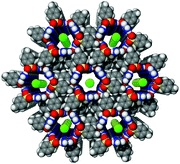
CrystEngComm, 2004,6, 401-407
https://doi.org/10.1039/B408258C
Probing helix formation in chains of vertex-linked octahedra
A discussion is presented on the rational synthesis of linear, zigzag or helical chains when two vertices of an octahedron, which are either adjacent (cis) or opposite (trans), are linked.
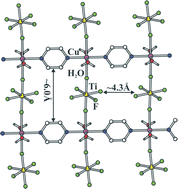
Quantifying intermolecular interactions and their use in computational crystal structure prediction
Crystal structure prediction studies of organic packing are highlighted, with particular emphasis on what they reveal about the transferability assumptions that underpin the use of empirical atom–atom intermolecular potentials and intuitive crystal design.
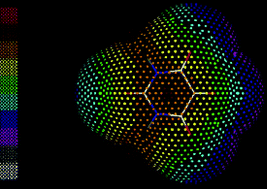
CrystEngComm, 2004,6, 344-353
https://doi.org/10.1039/B406598K
Mechanochemical and solution preparation of the coordination polymers Ag[N(CH2CH2)3N]2[CH3COO]·5H2O and Zn[N(CH2CH2)3N]Cl2
Two solid-state coordination reactions for the polymers g[N(CH2CH2)3N]2[CH3COO]·5H2O and Zn[N(CH2CH2)3N] and their solution counterparts, as well as two discussions of X-ray results are presented.
![Graphical abstract: Mechanochemical and solution preparation of the coordination polymers Ag[N(CH2CH2)3N]2[CH3COO]·5H2O and Zn[N(CH2CH2)3N]Cl2](/en/Image/Get?imageInfo.ImageType=GA&imageInfo.ImageIdentifier.ManuscriptID=B406375A&imageInfo.ImageIdentifier.Year=2004)
CrystEngComm, 2004,6, 459-462
https://doi.org/10.1039/B406375A
A 1H NMR study of crystal nucleation in solution
1H NMR complexation-induced changes in chemical shift can be used to determine high resolution three-dimensional structures of complexes in solution, as well as for probing the organisation of molecules in the solid state.

CrystEngComm, 2004,6, 490-493
https://doi.org/10.1039/B407163H
High-pressure recrystallisation—a route to new polymorphs and solvates
Recrystallisation of organic compounds from solution at high pressure is shown to be a powerful technique for the discovery of new polymorphs and solvates. A new polymorph of phenanthrene and a new dihydrate of paracetamol have been discovered and structurally characterised.
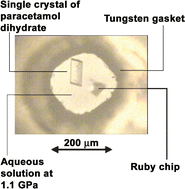
CrystEngComm, 2004,6, 505-511
https://doi.org/10.1039/B406631F
Weak C–H⋯O interactions and their rôle in simple amine crystal structures
Small differences in methylene C–H⋯O intermolecular contacts are analyzed by X-ray crystallography and by CSD data.
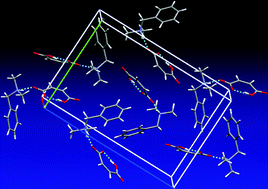
CrystEngComm, 2004,6, 495-503
https://doi.org/10.1039/B406676F
The strength–length relationship at the light of ab initio computations: does it really hold?
The validity of the so-called strength–length correlation (“the shorter the contact, the stronger it is”) has been evaluated for short O–H⋯O contacts by correlating the MP2 interaction energy with the O–H⋯O distance.
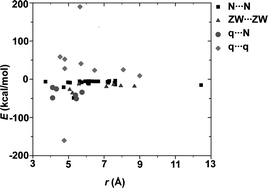
CrystEngComm, 2004,6, 368-376
https://doi.org/10.1039/B406743F
Synthetic crystallography : synthon mimicry and tecton elaboration in metallate anion salts
Examination is performed of a series of salts of square planar metallate anions involving a range of ligands. The hydrogen bonding capacity of these anions and the manner in which such interactions dictate the motifs and the resulting crystal structures is examined. This study explores the prospects for the planned elaboration of molecular species, tectons, as programmed components of crystal structures.
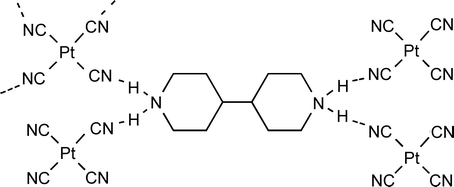
CrystEngComm, 2004,6, 419-428
https://doi.org/10.1039/B407722A
Cobalt 2,2′-biimidazole complexes co-crystallised with di-acids — synthesis, structure and quantum chemical calculations
The synthesis and crystal structure of [Co(Hbiim)2(H2biim)]2(p-OOCC6H4COOH)2·H2O is presented. Quantum chemical calculations (DFT and semi-empirical methods) were used by estimation of the directional forces in the structure.
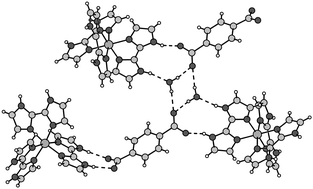
CrystEngComm, 2004,6, 355-359
https://doi.org/10.1039/B406518B
Conservation of self-associated dimers in solvates of a novel Horning-crown macrocycle
Dimers formed by self-association of a novel Horning-crown macrocycle appear in a number of inclusion complexes/solvates. These dimers, stabilised by π–π interactions, are conserved, but on crystallisation diverse packing motifs and inclusion occur.
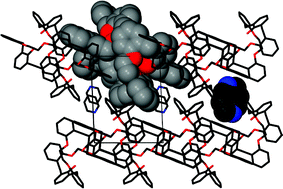
CrystEngComm, 2004,6, 485-488
https://doi.org/10.1039/B408881F
Protonated malonate: the influence of the hydrogen bonds on the magnetic behaviour
Three new compounds [Cu(Hmal)2 and Cu(H2O)(H2mal)(mal)], in which three species of the malonate (H2mal, Hmal−, and mal2−) are present, have been prepared and structurally characterised. The effectiveness of the magnetic exchange coupling was investigated as related to the degree of protonation of the malonate group.
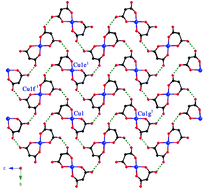
CrystEngComm, 2004,6, 444-450
https://doi.org/10.1039/B406529H
Phenylamines as building blocks to layered inorganic–organic structures
Crystallographic study is reported on complexes of metal chloride and amines forming layered inorganic–organic hybrid structures. The structures are based on anionic metal halide hydrogen bond acceptors and cationic phenylammonium N–H donors.
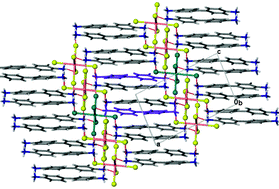
CrystEngComm, 2004,6, 438-442
https://doi.org/10.1039/B406671E
Crystallization-induced dynamic resolution and analysis of the non-covalent interactions in the crystal packing of peptide –biphenyl hybrids
The crystal structures of three peptide–biphenyl hybrids are reported. These compounds crystallize in helical structures maintained by extensive H-bond arrays. The results show the mutual influences of the molecular and supramolecular structures in the solid state.
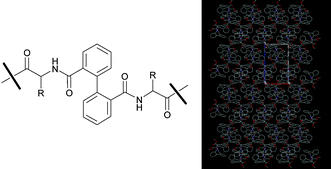
CrystEngComm, 2004,6, 513-521
https://doi.org/10.1039/B406652A
Formation of BaSO4 nanoribbons from a molecular mangle
A surface film that acts as a molecular mangle is described that delivers continuous ribbons of selected crystals with nm thickness. Initially, this has been evaluated for BaSO4. The approach is shown to be successful at preparing metastable nanoribbons of barite. The opportunities that this provides for crystal engineering more generally are discussed.

CrystEngComm, 2004,6, 470-473
https://doi.org/10.1039/B406745M
Interpenetrating metal–organic and inorganic 3D networks: a computer-aided systematic investigation. Part I. Analysis of the Cambridge structural database
The occurrence of interpenetration in metal–organic and inorganic networks has been investigated by a systematic analysis of the CSD and ICSD structural databases. For this purpose, a novel version of TOPOS (a program package for multipurpose crystallochemical analysis) has been employed, where the recognition of interpenetrating nets is based on the representation of a crystal structure as a finite reduced graph.
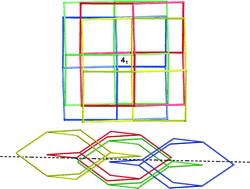
CrystEngComm, 2004,6, 377-395
https://doi.org/10.1039/B409722J
Controlling molecular and supramolecular structure of hydrogen-bonded coordination compounds
A supramolecular assembly strategy for coordination networks is described, which utilizes cis-protecting ligand that generate neutral tectons with two available trans positions where a supramolecular reagent can bind to generate extended hydrogen bonded networks.
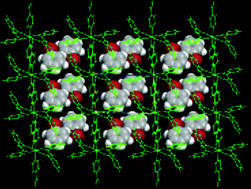
CrystEngComm, 2004,6, 413-418
https://doi.org/10.1039/B410129B
Designing neutral coordination networks using inorganic supramolecular synthons: Combination of coordination chemistry and C–H⋯Cl hydrogen bonding
Two compounds [(L3)MnCl2(EtOH)] and [(L6)FeCl3] were synthesized and structurally characterized in network design. It was demonstrated that these coordination units can be used effectively as supramolecular synthons in crystal engineering to construct neutral networks.

CrystEngComm, 2004,6, 396-400
https://doi.org/10.1039/B406744B
Co-crystallization with acetylene . Part III. Molecular complexes with aromatic azacycles
The paper is a detailed analysis of acetylene∶pyridine type co-crystals characterized by low-temperature X-ray diffraction where intermolecular interactions are evaluated in their importance for the packing.
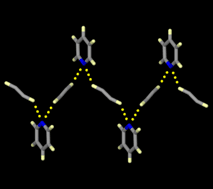
CrystEngComm, 2004,6, 361-366
https://doi.org/10.1039/B410636A
Incorporation of sulfonate dyes into hydrogen-bonded networks
The methyl orange anion has been incorporated into hydrogen bonding networks through use of guanidinium and substituted guanidinium cations. [C(NH2)3][O3SC6H4N![[double bond, length as m-dash]](https://www.rsc.org/images/entities/char_e001.gif) NC6H4NMe2] reacts with hydrochloric acid to give the zwitterionic compound O3SC6H4NH
NC6H4NMe2] reacts with hydrochloric acid to give the zwitterionic compound O3SC6H4NH![[double bond, length as m-dash]](https://www.rsc.org/images/entities/char_e001.gif) NC6H4NMe2 whereas solid samples reversibly absorb HCl gas.
NC6H4NMe2 whereas solid samples reversibly absorb HCl gas.
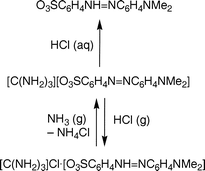
CrystEngComm, 2004,6, 429-436
https://doi.org/10.1039/B406614F
Crystal to crystal transformation in the solid state
Even in the solid state, crystal-to-crystal transformation for three diol-BQ adducts, rac-BN-BQ, 2BP-BQ and 4BP-BQ, occurs without going through an amorphous intermediate. This indicates that molecules can diffuse substantially, sever and form hydrogen bonds, and rearrange themselves to form a 3-D periodicity in the solid state.

CrystEngComm, 2004,6, 464-468
https://doi.org/10.1039/B408971E
ROP relationships between coordination polymers and discrete complexes: discrete bowl-shaped isomers of a 2-dimensional {M4L3}n polymer
The synthesis and structure of 2-D silver(I) coordination polymers of triphosphines with heterocyclic cores are described. They are formally related by ring-opening polymerisation to a porous ‘chickenwire’ coordination polymer, obtained with a the benzene-cored triphosphine 1,3,5-tris(diphenylphosphino)benzene.
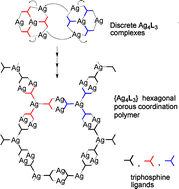
CrystEngComm, 2004,6, 408-412
https://doi.org/10.1039/B404468A
About this collection
Papers from the second CrystEngComm Discussion meeting, held from the 8th - 10th September 2004.